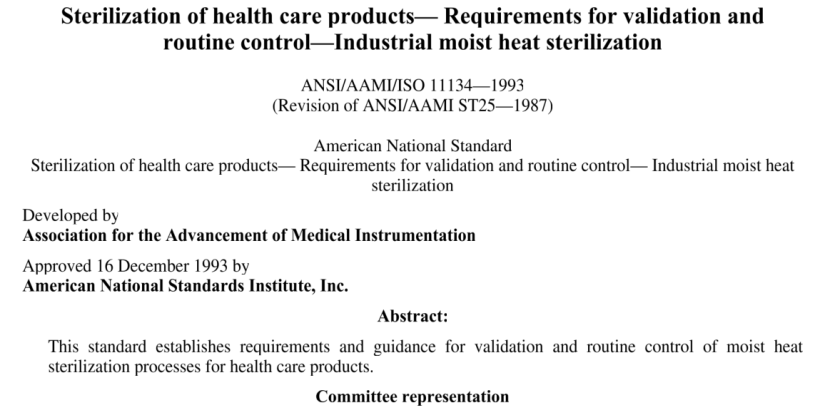ANSI AAMI ISO 11134-1993 pdf download
ANSI AAMI ISO 11134-1993 pdf download.Sterilization of health care products – Requirements for validation and routine control – Industrial moist heat sterilization
1 Scope
st heat processes, including saturated steam and air-steam mixtures, and applies to all industrial manufacturers and all others who perform contract moist heat sterilization. Although moist heat sterilization in non-industrial health care facilities is not specifically covered in this International Standard, the principles outlined may be useful to the user of moist heat sterilization in these facilities. NOTE 1 While the general requirements of this International Standard may apply to the sterilization of pharmaceuticals, other technical or regulatory requirements may also apply. This International Standard does not cover the quality assurance system which is necessary to control all stages of manufacture, including the sterilization process.
3.12 moist heat: Heat that iS derived trom water, either as a liquid or as steam under pressure.
3.13 moist heat sterilization: Process of using moist heat to produce a sterile product.
3.14 primary packaging: Element of the packaging system that maintains the sterility of the product.
3.15 process lethality: Capability of the sterilization process to destroy microorganisms. NOTE 4 This can be determined by measurements of microbial death or by establishing and measuring the required physical parameters.
3.16 product carrier system: Mechanism used to hold the product and its packaging for sterilization. NOTE 5 The carrier system should prevent product damage and allow uniform access by the sterilizing agent.
3.17 recommissioning: Repetition of part or all of the commissioning test requirements for the purpose of reconfirming process reliability.
3.18 revalidation: Repetition of part or all of the validation test requirements for the purpose of reconfirming process reliability.
3.19 saturated steam: Water vapor at a temperature corresponding to the boiling point of the source liquid.
3.20 simulated product load: Load that is used as an alternative to the actual product load and that represents an equal or greater challenge to the process.
3.21 sterile: State of being free from viable microorganisms. NOTE 6 In practice no such absolute statement regarding the absence of microorganisms can be proven (see sterilization).
3.23 sterilization cycle: Automatic sequence of operating stages performed in the sterilizer.
3.24 sterilization process development: Studies conducted to develop a reproducible process by which the product can be sterilized to the desired probability of a non-sterile unit without damage.
3.25 validation: Documented procedure for obtaining, recording and interpreting the results required to establish that a process will consistently yield product complying with predetermined specifications. NOTE 8 Validation covers three activities: commissioning, verification of process specification and performance qualification.
3.26 z value: Number of degrees of temperature required for a l-logarithm change in the D value.
4 General
4.1 Responsibilities and training of personnel Responsibility for the installation and maintenance of moist heat sterilizers, for the validation and routine control of moist heat sterilization, and for the release of sterilized product shall be assigned to qualified personnel as specified in ISO 9001 or in ISO 9002.
4.2 Product considerations
The product shall be designed to comply with its specification and requirements for safety and efficacy following exposure to the maximum number of sterilization cycles specified for the product. If any treatment is required prior to sterilization (for example, cleaning) this shall also be validated as part of the resterilization procedure. The product shall be designed and materials shall be selected to be compatible with environmental changes occurring in the sterilization chamber during the sterilization cycle.
